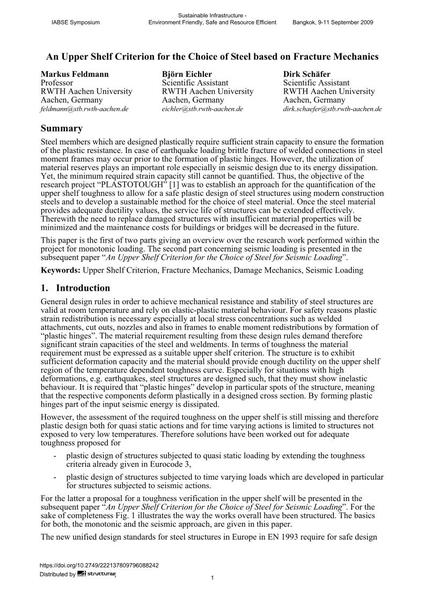An Upper Shelf Criterion for the Choice of Steel based on Fracture Mechanics

|
|
|||||||||||
Bibliografische Angaben
| Autor(en): |
Markus Feldmann
Björn Eichler Dirk Schäfer |
||||
|---|---|---|---|---|---|
| Medium: | Tagungsbeitrag | ||||
| Sprache(n): | Englisch | ||||
| Tagung: | IABSE Symposium: Sustainable Infrastructure - Environment Friendly, Safe and Resource Efficient, Bangkok, Thailand, 9-11 September 2009 | ||||
| Veröffentlicht in: | IABSE Symposium Bangkok 2009 | ||||
|
|||||
| Seite(n): | 218-229 | ||||
| Anzahl der Seiten (im PDF): | 8 | ||||
| Jahr: | 2009 | ||||
| DOI: | 10.2749/222137809796088242 | ||||
| Abstrakt: |
Steel members which are designed plastically require sufficient strain capacity to ensure the formation of the plastic resistance. In case of earthquake loading brittle fracture of welded connections in steel moment frames may occur prior to the formation of plastic hinges. However, the utilization of material reserves plays an important role especially in seismic design due to ist energy dissipation. Yet, the minimum required strain capacity still cannot be quantified. Thus, the objective of the research project “PLASTOTOUGH” [1] was to establish an approach for the quantification of the upper shelf toughness to allow for a safe plastic design of steel structures using modern construction steels and to develop a sustainable method for the choice of steel material. Once the steel material provides adequate ductility values, the service life of structures can be extended effectively. Therewith the need to replace damaged structures with insufficient material properties will be minimized and the maintenance costs for buildings or bridges will be decreased in the future. This paper is the first of two parts giving an overview over the research work performed within the project for monotonic loading. The second part concerning seismic loading is presented in the subsequent paper “An Upper Shelf Criterion for the Choice of Steel for Seismic Loading”. |
||||
| Stichwörter: |
Bruchmechanik Erdbebenbelastung
|
||||
